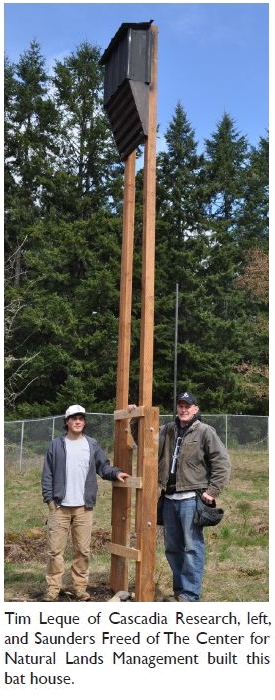Six new bat boxes bring the big brown batsBy Linda Saunders
The nursery box should be inviting to the big brown bat (Eptesicus fuscus), one of the larger species of bats found in Washington. Size is definitely relative when it comes to bats; the big brown bat is a whopping 4½ inches long with a 13 inch wing span. Compared to the little brown bat she is a mammoth! The big brown bat is one of the most common bats in the northwest as well as in the entire United States, including Alaska. She typically hibernates in attics, caves and mines, but during the summer, large maternity colonies of up to 700 may share a home. We could have over 200 pups in our nursery box each season! Big brown bats usually only have a single pup, which is able to fly in 35 days, and could live more than 19 years! The other bat boxes at Wolf Haven Intl. are designed to entice other species, and offer a variety of digs for discerning residents. All bats hibernate, and use man-made bat boxes along with tree cavities, caves and even old (and new) human structures. If you were to peek inside one of our bat boxes, you would see bats hanging upside down. Bats are the only animal that can lock their toes in place when supporting their weight. They also have a special circulatory system that allows them to hang upside down for hours, something no other animal is able to do. Why are we so excited about having bats on our site? Just like wolves, bats are considered a keystone species; so many other plants and animals depend upon them for their survival. This is because some bats are pollinators, and some eat fruit and disperse the seeds of plants critical to habitats such as the deserts of the American southwest and tropical rainforests. Our bats consume a huge number of flying insects, including mosquitoes, moths, gnats, crane flies, wasps, beetles and flies. Our wetland offers a rich variety of insects including lots and lots of mosquitoes. After eating, many of our bats rest with full bellies in cracks and crevices on our outside gift shop wall. In addition to their insect consuming and pollinating services, bats are considered by many to produce the best fertilizer, called guano. Bats all over the world are in trouble, and nearly half are threatened or endangered in the US. In Washington, nine bat species are "Species of Special Concern" and eight are Candidates under the Endangered Species Act. Other Candidate species at Wolf Haven Intl. are the Mazama pocket gopher, and perhaps the spotted frog. Bats are declining because they are losing their roosting and hibernating habitat at a rapid pace as we cut down old growth forests and make our homes more energy efficient, and "bat proof." They are also very sensitive to pesticides and to disturbance during hibernation. Bats that waken during hibernation use up valuable energy reserves investigating a threat, and may not have enough reserves to live on until spring. Besides the big brown bat, you could see the little brown bat, the California myotis, Keen's myotis, western long-eared myotis, silver-haired bat, fringed myotis, hoary bat, long-legged myotis and others at Wolf Haven Intl. Bats will be surveyed this year to identify which variety seems to like our habitat the most. Stay tuned! For more information on bats in Washington, ways to help bats, and what to do if you find a dead or live bat, visit www.batsnorthwest.org. To see live bats at sites in Washington see http://wdfw.wa.gov/wildwatch/ Linda Saunders is the Director of Conservation at Wolf Haven International.
Back to Home page. |

 Wolf Haven International is taking 2012's International Year of the Bat seriously. Lots of bats use the wetland adjacent to our sanctuary for their nightly insect feeds and daytime roosting. We have eleven of the thirteen species of bats that live in Washington, and they now have even more reason to "hang around" with the recent addition of six new bat boxes near our wetland. Sanders Freed of The Center for Natural Lands Management built and erected the boxes to lure a variety of bats. One in particular is a nursery box which hopefully will soon be filled young bats (interesting note: baby bats are called "pups" just like wolves).
Wolf Haven International is taking 2012's International Year of the Bat seriously. Lots of bats use the wetland adjacent to our sanctuary for their nightly insect feeds and daytime roosting. We have eleven of the thirteen species of bats that live in Washington, and they now have even more reason to "hang around" with the recent addition of six new bat boxes near our wetland. Sanders Freed of The Center for Natural Lands Management built and erected the boxes to lure a variety of bats. One in particular is a nursery box which hopefully will soon be filled young bats (interesting note: baby bats are called "pups" just like wolves).